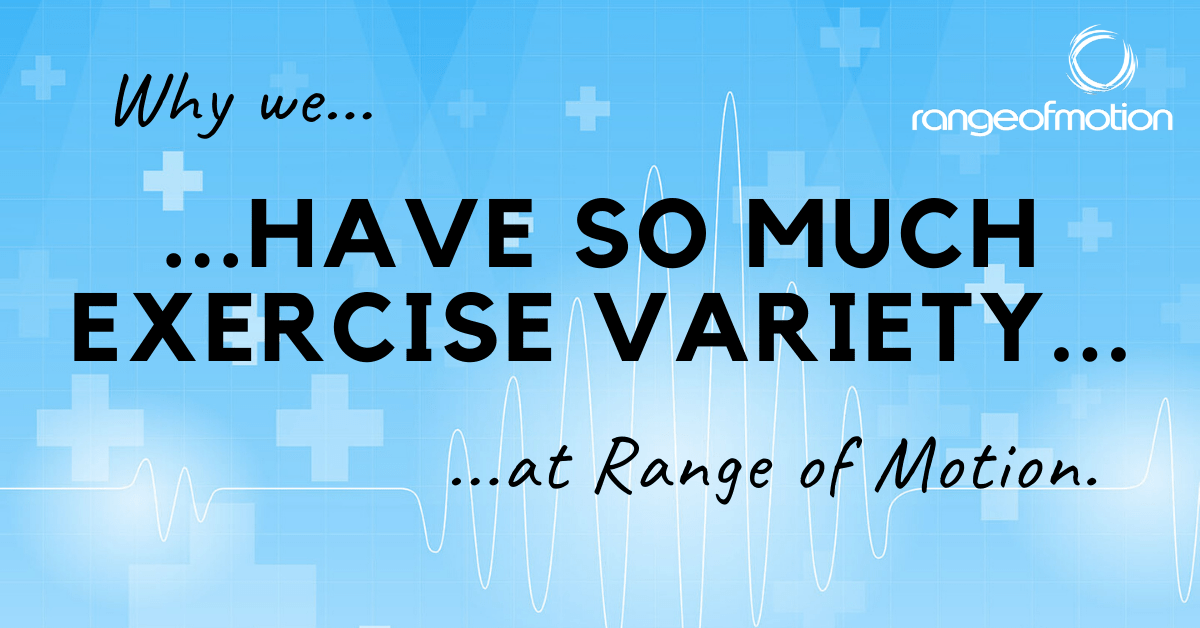Why we have so much exercise variety at Range of Motion.
 At Range of Motion, we complete a huge variety of different exercises (and for good reason, which we’ll discuss shortly).
At Range of Motion, we complete a huge variety of different exercises (and for good reason, which we’ll discuss shortly).
But, surprisingly we don’t actually complete many different movements. So what’s the difference?
Movements are the patterns and shapes our body is capable of going in to.
There are a finite number of different movements our bodies can do. For example, we can do a squat. We can pick something up off the ground (a deadlift). We can lift something overhead. There are a few more, but not many. However, there are countless exercises that we can do for each of these movements.
Let’s look at the example of lifting something from shoulder height to overhead. You can lift a barbell overhead. You can lift a barbell overhead with the assistance of your legs. You can lift dumbbells overhead (or you can lift just one dumbbell overhead). You can lift in a standing position, or a seated position, or a kneeling position. So even though this is only one movement (lifting something overhead), there are a vast range of different exercises that fit this movement pattern.
At Range of Motion, when we program an exercise session, we program it with a certain intent. It’s designed to help you improve your health and fitness in some way. And often, we can do this by combining certain combinations of movements. However, there is some freedom when it comes to which exercises you chose to complete for each movement.
We call these movement alternatives. And in some sessions in our Range of Motion Programming software, you have the option to choose an exercise from a drop down menu of these movement alternatives for each movement we program. Learn more about how Range of Motion Programming individualises your program just for you.
There are two big benefits of the variety this gives you.
Firstly, there’s a psychological benefit. The vast range of exercises that we have to choose from keep your training fresh and interesting. There’s a huge amount of value from ‘novel’ movements. It’s possible for your training to be novel and stimulating while still being highly effective. This novelty means there’s not a lot of repetition and it keeps your training interesting.
The second major benefit is the physical benefit.
If we go back to our example of lifting something from shoulder height to overhead, you’ll remember that we could lift a barbell, or dumbbells (or any other object), and we can lift these objects in a variety of different ways. But the beauty fo using movement alternatives, is that by lifting dumbbells, you’ll get better at lifting barbells (and vice versa). By lifting without one arm, you’ll get better at lifting with two arms (and vide versa). And by lifting in one position, you’ll get better at lifting in other positions.
Every exercise you do, will improve every other exercise you do.
So how does this improve your quality of the life in the real world (because that’s what really matters)?
Having a huge variety of exercises in training means you’re well prepared for the physical demands of life. You probably haven’t lifted dog food or potting mix or flour onto a high shelf in training. And you probably haven’t lifted your luggage into the overhead compartment. But you have done this same movement in countless combinations and variations. And because of this, you are prepared for it.
This variety also improves the health of your musculo-skeletal system (your muscles and joints). Because there are subtle variations in what you’re doing, you’re forcing your body to adapt to slight differences, which means you’re building stronger joints. Learn more about how the exercises we do improves your musculo-skeletal health by reading ‘Why we prioritise movement quality at Range of Motion.
By choosing single arm or leg (we call this ‘unilateral’) exercises, you also have the added bonus of building stable joints, which will reduce injury rates and keep you functional in the long term. These unilateral exercises are also great for identifying and correcting imbalances in your body.
You can learn about how different LENGTHS of exercise sessions can be of benefit too, by reading ‘Why we do sessions lasting different lengths of time at Range of Motion‘.
Movement alternatives can also be a great strategy if you’re training to improve your sporting performance, or to excel at a certain event. Sometimes, in competition, as in life, you will come up against unpredictable events. By introducing variety in training, you’ll be prepared for these unknowns.
The best advice to get all these benefits to your mental health, your physical health, and your performance, is to choose novel movement alternatives as often as possible.





